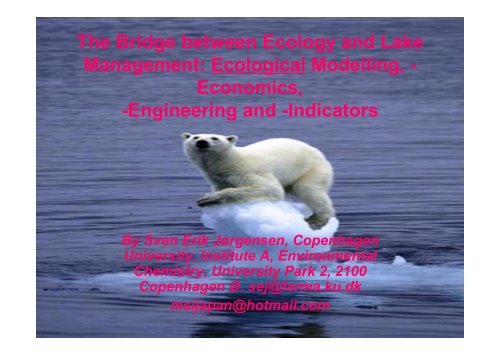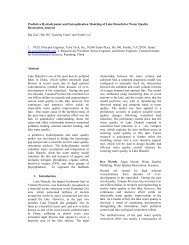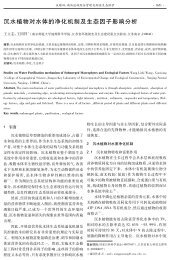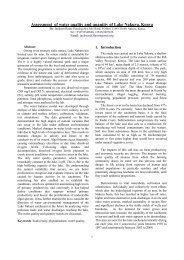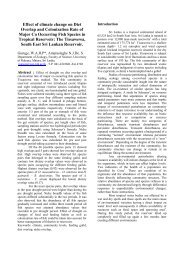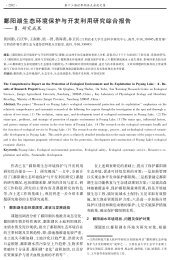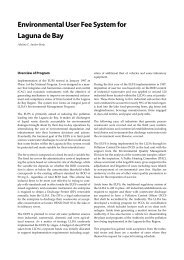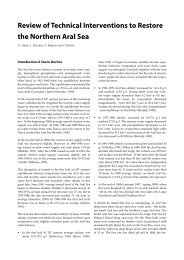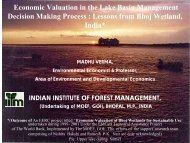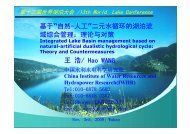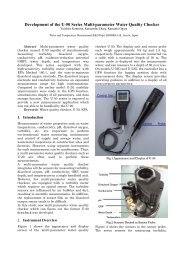Ecological Modelling
Ecological Modelling
Ecological Modelling
You also want an ePaper? Increase the reach of your titles
YUMPU automatically turns print PDFs into web optimized ePapers that Google loves.
The Bridge between Ecology and Lake<br />
Management: <strong>Ecological</strong> <strong>Modelling</strong>, -<br />
Economics,<br />
-Engineering and -Indicators<br />
By Sven Erik Jørgensen, Copenhagen<br />
University, Institute A, Environmental<br />
Chemistry, University Park 2, 2100<br />
Copenhagen Ø. sej@farma.ku.dk<br />
msijapan@hotmail.com
1962:<br />
• “The Silent Spring” by Rachel<br />
Carson started the first green<br />
wave
1970:<br />
The idea: Zero Discharge 1985 was<br />
introduced in USA, but was<br />
impossible to realize due to the<br />
economy- The solution to the<br />
problem was the application of<br />
ecological models. The needs for<br />
an ecological approach in<br />
environmental management<br />
became clear.
Urbanization<br />
IMPACT Ecosystem<br />
Industrialization<br />
Selection of<br />
environmental<br />
technology<br />
Reduction of<br />
impact by environmental<br />
technology<br />
<strong>Ecological</strong><br />
model of the<br />
changes causet<br />
by the<br />
impact
ENVIRONMENTAL<br />
TECHNOLOGY<br />
ECOLOGICAL<br />
MODELLING<br />
MAN<br />
ECOSYSTEMS<br />
CLEANER<br />
TECHNOLOGY,<br />
SUSTAINABLE<br />
DEVELOPMENT<br />
ENVIRONMENTAL<br />
LEGISLATION<br />
GLOBAL PROBLEMS:<br />
GREEN HOUSE EFFECT<br />
OZONE LAYER<br />
RAIN FOREST<br />
(ACID RAIN)<br />
ECOLOGICAL<br />
ENGINEERING/<br />
ECOTECHNOLOGY
1. Different scale dependent on purpose<br />
2. Different types dependent on the purpose<br />
Geology, railroad, aeroplan, marine maps.....<br />
3. A map cannot contain all information,<br />
details<br />
4. A map is a simplification of reality which<br />
is useful in a given context.
Streeter- Phelps<br />
Lotka-Volterra<br />
1920<br />
1950<br />
Population dynamics<br />
River models<br />
Eutrophication models<br />
Complex river models<br />
1970<br />
1975<br />
Fixed modeling procedure<br />
Balanced complexity<br />
More ecology<br />
1980<br />
Ecotoxicological models<br />
More case studies<br />
Validation of prognoses<br />
1990<br />
Structurally dynamic models<br />
<strong>Ecological</strong> constraints<br />
New mathematical tools, included<br />
machine learning<br />
2000
Advantages of <strong>Modelling</strong>:<br />
• Models are synthesis of all what we<br />
know- observations, theoretical<br />
knowledge, knowledge about rates and<br />
sizes, knowledge about food items etc.<br />
• Models are tools to overview complex<br />
systems<br />
• Models make it possible to quantify by<br />
the use of mathematical formulations and<br />
computers
Man made impact<br />
Control function<br />
(forcing function)<br />
Natural forcing<br />
function<br />
The ecosystem described<br />
by the use of state variables<br />
THE MODEL GIVES THE RELATIONSHIP<br />
BETWEEN FORCING FUNCTIONS AND<br />
STATE VARIABLES.
Bio-geo-chemical models<br />
5: >100 models, 4: 25-99 models, 3: 10-25 models,<br />
2: 4-9 models, 1: 1-2 models, 0: No models<br />
• Ecosystem<br />
# of models<br />
• Rivers, lakes, lagoons, estuaries 5<br />
• Wetlands, agricultural land 5<br />
• Forests, fjords, bays 5<br />
• Open sea, national parks, grassland 4<br />
• Savanna, mountain land 2<br />
• Desert, artic/anartic system 1<br />
• Mountain land above timberline 0
Bio-geo-chemical models<br />
5: >100 models, 4: 25-99 models, 3: 10-25 models,<br />
2: 4-9 models, 1: 1-2 models, 0: No models<br />
Problems<br />
# of models<br />
Oxygen depletion, eutrophication 5<br />
Pesticides, acid rain, groundwater pollution 5<br />
Global warming, ERA (toxic substances) 5<br />
Heavy metals, ozone layer, endangered sp. 4<br />
Health / pollution 3<br />
Endocrine disruptors, microclimate 2
A wide range of lake models have<br />
been developed to find possible<br />
solutions for<br />
• the eutrophication, several hundred models<br />
• the acidification, more than 100 models<br />
• Over-fishing, more than 50 models<br />
• the discharge of toxic substances, more than 100 models<br />
• siltation, more than 25 models<br />
• oxygen depletion, several hundred models<br />
• and<br />
• Salinization, ore than 10 models<br />
• These models have been extensively used in lake<br />
management.
Galilei: measure everything<br />
and what is not measurable<br />
make measurable
Galilei modified: model everything<br />
and, what is not modelable make<br />
modelable
The Ramification of <strong>Ecological</strong><br />
<strong>Modelling</strong><br />
• <strong>Ecological</strong> <strong>Modelling</strong><br />
2004 <strong>Ecological</strong><br />
Complexity<br />
1992 <strong>Ecological</strong><br />
Engineering<br />
2006 <strong>Ecological</strong><br />
Informatics<br />
2000 <strong>Ecological</strong><br />
Indicators<br />
1986 <strong>Ecological</strong><br />
Economy<br />
1975 <strong>Ecological</strong> <strong>Modelling</strong>
Development: Previously <strong>Ecological</strong> <strong>Modelling</strong><br />
published other topics in applied ecology. Now they<br />
are published in separate journals and <strong>Ecological</strong><br />
<strong>Modelling</strong> is only publishing <strong>Ecological</strong> Models and<br />
Ecosystem Theory<br />
• <strong>Ecological</strong> <strong>Modelling</strong> 1975: 320 pages<br />
• 1988 <strong>Ecological</strong> Economics<br />
• 1991 <strong>Ecological</strong> Engineering<br />
•<br />
• 2000 <strong>Ecological</strong> Indicators<br />
•<br />
• 2004 <strong>Ecological</strong> Complexity<br />
• 2006 <strong>Ecological</strong> Informatics<br />
•<br />
• <strong>Ecological</strong> <strong>Modelling</strong> 2009: 4000 pages<br />
• Citation index 2008: 2.18
Development: number of papers<br />
Stabilized around 380 papers /<br />
year 2008<br />
2008<br />
3 5 0<br />
3 0 0<br />
Number of papers / year<br />
2 5 0<br />
2 0 0<br />
1 5 0<br />
1 0 0<br />
5 0<br />
0<br />
1 9 8 4 1 9 8 6 1 9 8 8 1 9 9 0 1 9 9 2 1 9 9 4 1 9 9 6 1 9 9 8 2 0 0 0 2 0 0 2 2 0 0 4 2 0 0 6<br />
Y e a r
<strong>Ecological</strong> <strong>Modelling</strong>:<br />
• 380 papers per year and 4000 pages<br />
• Citation index has increased to<br />
• 2.18<br />
• It is also going excellently for the other<br />
journals <strong>Ecological</strong> Economics,<br />
<strong>Ecological</strong> Engineering, <strong>Ecological</strong><br />
Indicators, <strong>Ecological</strong> Complexity and<br />
<strong>Ecological</strong> Informatics
<strong>Ecological</strong> Economics<br />
• Models are used heavily and<br />
also published from time to<br />
time in <strong>Ecological</strong> <strong>Modelling</strong>
What is ecological engineering<br />
• Design of sustainable ecosystems that<br />
integrate human society with its natural<br />
environment to the benefit of both.<br />
• Notice that it is engineering in ecosystems,<br />
which implies that it is based on design<br />
principles and ecology
Type 3: ecosystems are recovered<br />
Environment / ecosystems / surrounding<br />
nature<br />
Type 1: ecostems<br />
are<br />
used to treat<br />
waste<br />
Society<br />
Type 2: ecosystems<br />
are constructed to<br />
treat waste<br />
Type 4: ecologically sound planning<br />
of the use of ecosystems
Subdisciplines of <strong>Ecological</strong><br />
Engineering:<br />
• Ecotechnology≈ ecological engineering<br />
• Ecohydrology: the use of hydrology to improve<br />
ecological conditions of ecosystem or the use of<br />
ecology to influence the hydrology<br />
• Phytoremediation: use of plants to remove<br />
pollutants for instance removal of toxic<br />
substances by plants<br />
• Phytotechnology: use of plants in ecotechnology
CONSTRUCTED<br />
WETLAND<br />
WITHDRAWAL OF WATER<br />
WATER TREATMENT<br />
LAKE<br />
REMOVAL OF PHOSPHO-<br />
RUS BY PRECIPITATION<br />
BEFORE DISCHARGE<br />
STREAM<br />
STREAM<br />
HYPOLIMNION WATER IS<br />
REMOVED BY SIPHONING
Adsorption of Pe,<br />
HM, P, OM, N<br />
Decomposition<br />
of Pe, OM<br />
Denitrification<br />
N<br />
Uptake by plants of<br />
Pe, HM, P, N<br />
Pesticides (Pe)<br />
Input<br />
Heavy metals (HM)<br />
Phosphorus (P)<br />
Organic matter (OM)<br />
Nitrogen<br />
compounds (N)<br />
Transport to<br />
limnetic zone<br />
Transition zone (ecotone)
Several lake restoration methods have<br />
been developed and used to recover<br />
lakes:<br />
• Aeration in lakes by air and oxygen<br />
• Biomanipulation<br />
• Precipitation of phosphorus directly in the lake<br />
• Neutralization of acids in the lakes<br />
• Use of wetlands for the removal of pollutants.<br />
• Siphoning of bottom water (often anaerobic and with a<br />
high phosphorus concentration)<br />
• Removal of the sediment (often with high<br />
concentrations of phosphorus and toxic substances)<br />
• Management of the lake hydrology by shorter retention<br />
time during the spring and summer or by decreasing<br />
the annual retention time.<br />
• Introduction of plant eating fish species
Epilimnion<br />
Hypolimnion<br />
Thermocline<br />
Column with activated<br />
aluminium oxide
Ecosystem Theory<br />
• Environmental Management of ecosystems<br />
requires that we know the system that we<br />
want to manage and it is furthermore<br />
important to know the system properties of<br />
the systems that we want to model<br />
• <strong>Ecological</strong> <strong>Modelling</strong> is publishing many<br />
system ecological papers, but <strong>Ecological</strong><br />
Complexity is an important supplement for<br />
publication of ecosystem theory
Recently at a brainstorming meeting on<br />
the Danish Island Møn, it was possible to<br />
“hang” 10 basic laws, proposed by SEJ<br />
on 5 ecosystem properties:
Recently at a brainstorming meeting on the<br />
Danish Island Møn, it was possible to<br />
“hang” these 10 laws on 5 ecosystem<br />
properties:
We do have an ecosystem theory! Why<br />
do we not apply this theory more<br />
widely inlake ecology and lake<br />
management?<br />
• It should be applied to explain<br />
ecological observations and used<br />
as tool in ecological modelling,<br />
engineering and for the assessment<br />
of ecosystem health by the use of<br />
ecological indicators!!
The Application of<br />
<strong>Ecological</strong> Indicators to<br />
assess Ecosystem Health<br />
<strong>Ecological</strong> Indicators are used<br />
increasingly as an environmental<br />
management tool – often as a<br />
supplement to ecological modelling<br />
It is also supplemented by assessment<br />
of ecosystem services
Important book:<br />
• Jørgensen, S.E., Robert<br />
Costanza and Xu Fuliu<br />
Handbook of Ecolgical Indicators<br />
for the Assessment of<br />
Ecosystem Health, crc, Lewis<br />
Publ. 2004. Second edition 2010
Do you know the disease?<br />
• The disease may define the<br />
indicator, for instance PCB<br />
pollution in the Great Lakes<br />
• Invasion by zebra mussels<br />
• (Lake Erie)
What should ecological<br />
indicators cover?<br />
• l) homeostasis;<br />
• 2) absence of disease,<br />
• 3) diversity or complexity;<br />
• 4) stability or resilience;<br />
• 5) vigor or scope for growth<br />
• 6) balance between system<br />
components
Two methods may be<br />
applied:<br />
• By Direct Measurements /<br />
Observations Method<br />
• By the Application of Models,<br />
for instance ECOPATH or a<br />
bio-geochemical model
Classification of <strong>Ecological</strong><br />
Indicators and their application in<br />
lake management<br />
• Reductionistic (single) indicators - like for<br />
instance PCB (Great Lake)<br />
• Species present / absent (many lakes)<br />
• Semiholistic indicators: f.inst. Odum’s<br />
attributes (many lakes)<br />
• Holistic indicators - biodiversity /<br />
ecological network (For instance the East-<br />
African lakes)<br />
• “Super-holistic” - thermodynamic<br />
indicators, such as emergy, exergy and<br />
the ratio exergy/ emergy (several lakes)
Conclusions I:<br />
Due to ecological modelling,<br />
ecological economics,<br />
ecological engineering<br />
and use of<br />
ecological indicators,<br />
we have to day lake<br />
management based on<br />
a solid ecological<br />
Knowledge - fortunately
Conclusions II:<br />
The lake management<br />
would probably have been<br />
more technological and<br />
less ecological to day if<br />
we would not have had<br />
the sub-disciplines in<br />
applied ecology to enhance<br />
the ecological considerations<br />
in lake management
Thank you for your attention


